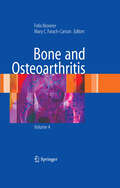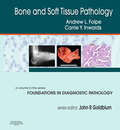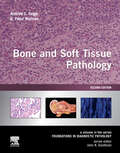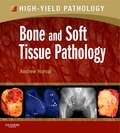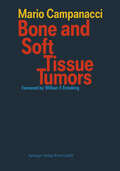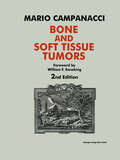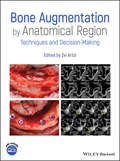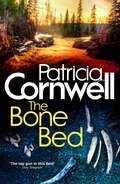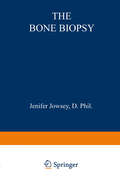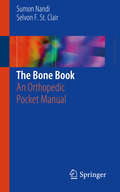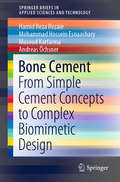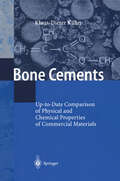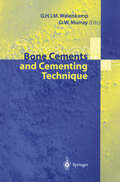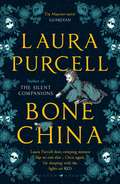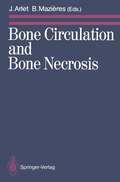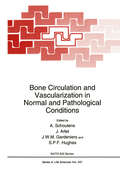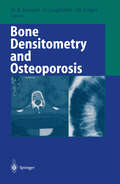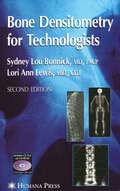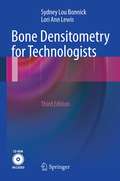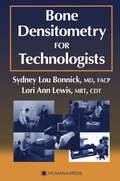- Table View
- List View
Bone and Joint Imaging E-Book
by Donald L. Resnick Mark J. KransdorfOver 3,800 exquisite images demonstrate every principle and capture the characteristic presentations of the most frequently encountered disorders. The result is a remarkably thorough, yet focused and pragmatic, source of clinical guidance.The New Edition updates and distills all of the most important content from Dr. Donald Resnick's 5-volume Diagnosis of Bone and Joint Disorders, 4th Edition into a single, concise source. Together with new co-editor Mark J. Kransdorf, MD, Dr. Resnick and 38 other distinguished experts zero in on the specific, state-of-the-art musculoskeletal imaging and interpretation knowledge practitioners need today.Provides 2,900 outstanding images that depict all important concepts, techniques, and findings. Represents a highly efficient review source for oral and written radiology examinations, as well as an indispensable reference tool for clinical practice. Covers hot topics such as spinal interventional procedures · cartilage imaging · disorders of muscle · diagnostic ultrasonography · internal derangement of joints · target-area approach to articular disorders · rheumatoid arthritis and related diseases · crystal-induced diseases · sports injuries · MR arthrography · and much more. Offers an increased emphasis on MR imaging, an increasingly important and versatile diagnostic modality. Presents many new illustrations not found in the Diagnosis of Bone and Joint Disorders, 4th Edition 5-volume set.
Bone and Joint Infections: From Microbiology to Diagnostics and Treatment
by Werner ZimmerliBONE AND JOINT INFECTIONS Explore this comprehensive presentation of bone and joint infections, including non-implant and implant-associated orthopedic infectionsIn the newly revised Second Edition of Bone and Joint Infections: From Microbiology to Diagnostics and Treatment, accomplished researcher and author Werner Zimmerli delivers a comprehensive overview of the most recent developments in the subject of bone and joint infection. Covering much of the new information appearing over the last five years, the book includes four new chapters presenting the diagnostic approach in bone and joint infections, discussing the identification of pathogens by non-culture techniques, management of multi-resistant bacteria in bone and joint infections by bacteriophages, and unusual microorganisms in periprosthetic joint infections.Many of the chapters are also updated to include new information on topics like eubacterial PCR, multiplex PCR, and the shotgun metagenomics approach. These subjects are of increased applicability and interest to increase the fraction of cases with identified pathogens. The book also helps clinicians to understand MRI-based images and rapidly interpret and plan for comprehensive therapy.Readers will also benefit from the inclusion of:A thorough introduction to the pharmacokinetics and pharmacodynamics of antibiotics in bone and preclinical models of infection in bone and joint surgeryAn exploration of native joint arthritis in children and adults, as well as an overview of septic arthritis of axial jointsA practical discussion of the general aspects of periprosthetic joint infection, as well as specific aspects of periprosthetic joint infection after total hip and knee, shoulder, elbow, and ankle arthroplastyA concise treatment of osteomyelitis in children and adultsPerfect for infectious disease specialists, microbiologists, orthopedic and trauma surgeons, and internists, Bone and Joint Infections: From Microbiology to Diagnostics and Treatment will also earn a place in the libraries of professionals working in the implant industry and pharmaceuticals, as well as clinical pharmacologists and rheumatologists.
Bone and Joint Infections: From Microbiology to Diagnostics and Treatment
by Werner ZimmerliBONE AND JOINT INFECTIONS Explore this comprehensive presentation of bone and joint infections, including non-implant and implant-associated orthopedic infectionsIn the newly revised Second Edition of Bone and Joint Infections: From Microbiology to Diagnostics and Treatment, accomplished researcher and author Werner Zimmerli delivers a comprehensive overview of the most recent developments in the subject of bone and joint infection. Covering much of the new information appearing over the last five years, the book includes four new chapters presenting the diagnostic approach in bone and joint infections, discussing the identification of pathogens by non-culture techniques, management of multi-resistant bacteria in bone and joint infections by bacteriophages, and unusual microorganisms in periprosthetic joint infections.Many of the chapters are also updated to include new information on topics like eubacterial PCR, multiplex PCR, and the shotgun metagenomics approach. These subjects are of increased applicability and interest to increase the fraction of cases with identified pathogens. The book also helps clinicians to understand MRI-based images and rapidly interpret and plan for comprehensive therapy.Readers will also benefit from the inclusion of:A thorough introduction to the pharmacokinetics and pharmacodynamics of antibiotics in bone and preclinical models of infection in bone and joint surgeryAn exploration of native joint arthritis in children and adults, as well as an overview of septic arthritis of axial jointsA practical discussion of the general aspects of periprosthetic joint infection, as well as specific aspects of periprosthetic joint infection after total hip and knee, shoulder, elbow, and ankle arthroplastyA concise treatment of osteomyelitis in children and adultsPerfect for infectious disease specialists, microbiologists, orthopedic and trauma surgeons, and internists, Bone and Joint Infections: From Microbiology to Diagnostics and Treatment will also earn a place in the libraries of professionals working in the implant industry and pharmaceuticals, as well as clinical pharmacologists and rheumatologists.
Bone and Joint Injuries: Trauma Surgery III (European Manual of Medicine)
by Hans-Jörg Oestern Otmar Trentz Selman UranuesThere currently is a clear tendency to an increasing number of accidental injuries in elderly people, in sport injuries and car crashes also in countries which recently joined the European Union and candidates to join the European Union. Patients expect very good functional results even after serious injuries. But in contrast to this development, Trauma Surgery as an independent field, is not yet established in all European countries. Therefore, it seems mandatory to compile a book that covers the state-of-the-art in Trauma Surgery. The book also serves to harmonise the practice of Trauma Surgery within the European Union, and to prepare for the exam of the U.E.M.S.
Bone and Osteoarthritis (Topics in Bone Biology #4)
by Felix Bronner Mary C. Farach-CarsonThe molecular and cellular approaches to the relationship of joint and bone problems distinguish this from other books on the topic. Advances in bone and joint biology enable practitioners to approach clinical problems more comprehensively. Emphasis on genetics and on newer viewpoints and approaches, exemplified by the possible effect of subchondral bone on osteoarthritis, gives a wider viewpoint to the reader and may enable novel approaches to solving a clinical problem.
Bone and Soft Tissue Pathology E-Book: A Volume in the Foundations in Diagnostic Pathology Series (Foundations in Diagnostic Pathology)
by Andrew L. Folpe Carrie Y. InwardsBone and Soft Tissue Pathology: A Volume in the Diagnostic Pathology Series, by Andrew L. Folpe, MD and Carrie Y. Inwards, MD, packs today's most essential bone and soft tissue pathology know-how into a compact, high-yield format! The book's pragmatic, well-organized approach—complemented by abundant full-color, high-quality illustrations and at-a-glance tables—makes it easy to access the information you need to quickly and accurately identify pathology specimens. The result is a practical, affordable reference for study and review as well as for everyday clinical practice.Reviews normal histology before examining abnormal findings, enabling you to conveniently compare their characteristics in one place at one time. Covers both neoplastic and non-neoplastic conditions of bone and soft tissue to equip you to meet a wide range of diagnostic challenges. Uses a consistent, user-friendly format to explore each entity's clinical features, pathologic features (gross and microscopic), ancillary studies, differential diagnoses, and prognostic and therapeutic considerations...making it easy to locate specific information on a particular entity. Features abundant boxes and tables throughout that enhance the presentation and accessibility of the material. Offers nearly 1,000 full-color, high-quality illustrations that demonstrate the key features of a wide variety of pathologic lesions to facilitate greater accuracy in identification of specimens.
Bone and Soft Tissue Pathology E-Book: A Volume in the Foundations in Diagnostic Pathology Series (Foundations in Diagnostic Pathology)
by John R. GoldblumNow fully revised to include recent advances in the field, the second edition of Bone and Soft Tissue Pathology, a volume in the Foundations in Diagnostic Pathology series, is an essential foundation text for residents and pathologists. The popular template format makes it easy to use, and new information throughout brings you up to date with what’s new in the field, including advances in molecular diagnostic testing and new diagnostic biomarkers. Practical and affordable, this resource is ideal for study and review as well as everyday clinical practice.Key features of this practical text include: A consistent, user-friendly format that explores each entity's clinical features, pathologic features (gross and microscopic), ancillary studies, differential diagnoses, and prognostic and therapeutic considerations. A focus on specific features of selected neoplastic and non-neoplastic entities, including broad and in-depth differential diagnoses. Review of normal histology before examining abnormal findings, enabling you to conveniently compare their characteristics in one place at one time. Clinical information on treatment and prognosis, enabling you to better understand the clinical implications of the diagnosis. Nearly 1,000 full-color, high-quality illustrations with extensive figure legends, as well as abundant boxes and tables throughout. What’s NEW in this edition: Advances in molecular diagnostic testing and its capabilities and limitations, including targeted/personalized medicine. New diagnostic biomarkers and their utility in differential diagnosis, newly described variants, and new histologic entities. The latest TNM staging and WHO classification systems. New co-editor Dr. Gunnlaugur Pétur Nielsen of Harvard Medical School joins Dr. Andrew L. Folpe and expert, internationally recognized pathologists who keep you up to date with the latest information in the field.
Bone and Soft Tissue Pathology E-Book: A Volume in the High Yield Pathology Series (High Yield Pathology)
by Andrew Horvai Thomas LinkSave time identifying and diagnosing pathology specimens with High Yield Bone and Soft Tissue Pathology, edited by Drs. Andrew Horvai and Thomas Link. Part of the High-Yield Pathology Series, this title is designed to help you review the key pathologic features of bone and soft-tissue malformations, recognize the classic look of each disease, and quickly confirm your diagnosis. Its templated format, excellent color photographs, concise bulleted text, and authoritative content will help you accurately identify more than 160 discrete disease entities.Find information quickly and easily with a templated, easy-to-reference format. Confirm your diagnoses with excellent color photographs that demonstrate the classic appearance of each disease. Find the answers you need fast with concise, bulleted text. Depend on authoritative information from leading experts in the field.
Bone and Soft Tissue Tumors: Clinical Features, Imaging, Pathology and Treatment
by Mario CampanacciA systematic treatise of tumors and tumor-like lesions occurring in bone and soft tissues. The introductory chapter presents the terminology, the basic principles for classification and diagnosis, the general principles of imaging, biopsy and histology, the staging system and evaluation of the surgical margins, the general principles of curettage, local adjuvants, en bloc resection and reconstruction, chemotherapy and radiotherapy. Each pathologic entity is described according to its epidemiology, localization, symptoms, imaging, gross pathology, histopathology, histogenesis and pathogenesis, differential diagnosis, course and stage, treatment and prognosis.
Bone Augmentation by Anatomical Region: Techniques and Decision-Making
by Zvi ArtziComprehensively describes bone augmentation techniques and their application to the different anatomical regions of the upper and lower jaws. Bone Augmentation by Anatomical Region is a unique, evidence-based guide focusing on each specific anatomical region – anterior maxilla, posterior maxilla, anterior mandible, and posterior mandible – in order to emphasize the correct implemented procedures needed to successfully perform oral osseous reconstruction. Numerous ridge augmentation techniques are covered, including: horizontal and vertical guided bone regeneration, autologous block transplantation, interpositional bone grafting, allogeneic blocks, sandwich technique, split-expansion ridge technique, and sinus floor grafting. Non-augmented approaches such as forced socket site extrusion and the installation of digitally printed implants are also presented and discussed. Guides readers on tackling bone augmentation via anatomical region of the jaws and their related surrounding muscles, vascularization and innervation Presents innovative augmentation techniques for the anterior maxilla, posterior maxilla, anterior mandible, and posterior mandible Includes clinical photographs in each section and a decision tree to help readers select the appropriate surgical modality Bone Augmentation by Anatomical Region is a specialist resource suitable for dentists who practice implant dentistry, oral surgeons, oral and maxillofacial surgeons, periodontists, and postgraduate dental students in the above-mentioned disciplines.
Bone Augmentation by Anatomical Region: Techniques and Decision-Making
by Zvi ArtziComprehensively describes bone augmentation techniques and their application to the different anatomical regions of the upper and lower jaws. Bone Augmentation by Anatomical Region is a unique, evidence-based guide focusing on each specific anatomical region – anterior maxilla, posterior maxilla, anterior mandible, and posterior mandible – in order to emphasize the correct implemented procedures needed to successfully perform oral osseous reconstruction. Numerous ridge augmentation techniques are covered, including: horizontal and vertical guided bone regeneration, autologous block transplantation, interpositional bone grafting, allogeneic blocks, sandwich technique, split-expansion ridge technique, and sinus floor grafting. Non-augmented approaches such as forced socket site extrusion and the installation of digitally printed implants are also presented and discussed. Guides readers on tackling bone augmentation via anatomical region of the jaws and their related surrounding muscles, vascularization and innervation Presents innovative augmentation techniques for the anterior maxilla, posterior maxilla, anterior mandible, and posterior mandible Includes clinical photographs in each section and a decision tree to help readers select the appropriate surgical modality Bone Augmentation by Anatomical Region is a specialist resource suitable for dentists who practice implant dentistry, oral surgeons, oral and maxillofacial surgeons, periodontists, and postgraduate dental students in the above-mentioned disciplines.
The Bone Bed (Kay Scarpetta #Bk. 20)
by Patricia CornwellThe twentieth book in the Kay Scarpetta series, from No. 1 bestselling author Patricia Cornwell. 'America's most chilling writer of crime fiction' The TimesA woman has vanished while digging a dinosaur bone bed in the remote wilderness of Canada. Somehow, the only evidence has made its way to the inbox of Chief Medical Examiner Kay Scarpetta, over two thousand miles away in Boston. She has no idea why.But as events unfold with alarming speed, Scarpetta begins to suspect the paleontologist's disappearance is connected to a series of crimes much closer to home: a gruesome murder, inexplicable tortures, and trace evidence from the last living creatures of the dinosaur age.When she turns to those around her, Scarpetta finds that the danger and suspicion have penetrated even her closest circles. Her niece Lucy speaks in riddles. Her lead investigator Pete Marino and FBI husband Benton Wesley have secrets of their own. Feeling alone and betrayed, Scarpetta is tempted by someone from her past as she tracks a killer both cunning and cruel.
The Bone Book: An Orthopedic Pocket Manual
by Sumon Nandi Selvon F. St. ClairThe Bone Book: An Orthopedic Pocket Manual is a complete guide to the essentials of orthopedics in today's busy hospital and outpatient settings. Concise chapters provide the basic knowledge that all orthopedic surgery residents, medical students, and supporting staff must know to handle the full range of conditions, injuries, and diseases for patients in the operating room and emergency department. Included are essentials of musculoskeletal anatomy, physical examination, orthopedic emergencies, and emergency room consults, including care for fractures, dislocations, bone/joint infections, and spinal cord injuries. Additional chapters cover operative room basics, such as patient positioning, prepping, and draping, and common orthopedic techniques, such as splinting, joint aspiration, and regional blocks. By compiling information commonly passed down from senior to junior surgeon, the authors have distilled a wide range of orthopedic fundamentals into one easy-to-read book.
Bone Cement: From Simple Cement Concepts to Complex Biomimetic Design (SpringerBriefs in Applied Sciences and Technology)
by Hamid Reza Rezaie Mohammad Hossein Esnaashary Masoud Karfarma Andreas ÖchsnerThis book provides an overview of the composition of polymeric and ceramic bone cements. It also discusses complex, biomimetic structures based on biomaterials, such as cells and bioactive molecules, which more closely resemble natural bone The first chapter describes the main concepts of the cementation process and the parameters affecting it, while the second chapter focuses on the composition and structure of candidate biomaterials. Lastly, the third and fourth chapters present recent research aimed at improving the ability of naked biomaterials to enhance bone healing by adding cells and bioactive agents.
Bone Cements: Up-to-Date Comparison of Physical and Chemical Properties of Commercial Materials
by Klaus-Dieter KühnMethyl methacrylate (MMA) is the basic component of bone cements. To use it, a dough is prepared from the liquid and powder by mixing right before application, which is normally done by the operating team. During its working phase the dough is then inserted into the tissue where polymerization is completed. Thus, the final implant polymethyl methacrylate (PMMA) is only created at the implantation site. Besides methyl methacrylate, bone cements sometimes contain other methacrylates, such as butyl methacrylate. To achieve X-ray opacity, radiopacifiers (zirconium dioxide or barium sulfate) are added to the powder. Both the liquid and powder components contain additives (initiator and activator) that launch polymerization and control the set ting when mixed together. Moreover, softener and emulsifiers are some times used. The addition of antibiotics to the powder component in order to prevent or treat infections has become especially important. Commercial bone cements differ in composition and the course of curing. Some are designed for high and others for low viscosity. The way the user handles and applies the cement always crucially influences the quality of the implant. This is why clear and comprehensive information about the cements should be available to show the user how all the relevant factors work It should also be possible together and how they depend on each other.
Bone Cements and Cementing Technique
by U. Henze H. J. KockG. H. I. M. WALENKAMP, D. W. MURRAY Since the first use of bone cement, there has been much discussion about this important tool in arthroplasty. Many authors consider the cemented prosthesis as the gold standard when evaluating the outcome of primary prostheses. In a large number of total hip arthroplasties, as registered in the Scandi navian Hip Registers, important differences in revision risks have been docu mented between hospitals. These differences are partly due to the use of di verse cement techniques. In the analysis of data, the influence of these tech niques, as well as the different cement types, is clear. A recent disaster with a newly developed cement also illustrated that the quality of the cement must be assured, and that the introduction of a new material must be carefully prepared and followed-up. The new Palamed cement has been developed by the makers of the well known Palacos and Refobacin Palacos, which appeared to be the best ce ments in the Swedish register. An improvement was noted in slightly better handling characteristics, but the end product is the same as Palacos. As men tioned, this cement will be carefully followed-up in the near future. However, its introduction is a good reason to gather the expertise of some of the lead ing figures in the field in this book. II History of Bone Cements CHAPTER 2. 1 Industrial Development of Bone Cement Twenty-Five Years of Experience w. EGE, K. D.
Bone China: A wonderfully atmospheric tale for winter reading
by Laura Purcell'Du Maurier-tastic' GUARDIAN'Deliciously sinister' HEAT 'A clever, creepy read' SUNDAY EXPRESS Consumption has ravaged Louise Pinecroft's family, leaving her and her father alone and heartbroken. But Dr Pinecroft has plans for a revolutionary experiment: convinced that sea air will prove to be the cure his wife and children needed, he arranges to house a group of prisoners suffering from the same disease in the cliffs beneath his new Cornish home. Forty years later, Hester Why arrives at Morvoren House to take up a position as nurse to the now partially paralysed and almost entirely mute Miss Pinecroft. Hester has fled to Cornwall to try and escape her past, but surrounded by superstitious staff enacting bizarre rituals, she soon discovers that her new home may be just as dangerous as her last…
Bone Circulation and Bone Necrosis: Proceedings of the IVth International Symposium on Bone Circulation, Toulouse (France), 17th–19th September 1987
by J. Arlet and B. MazièresBone Circulation and Vascularization in Normal and Pathological Conditions (Nato Science Series A: #247)
by A. Schoutens J. Arlet Jean Wm Gardeniers S P F HughesThe Association Internationale de Recherche sur la Circulation Osseuse, A.R.C.O., was founded in London in December 1989 by a small group of doctors, surgeons and researchers in basic sciences who had been involved for many years in the study of bone circulation and its disorders. They had met several times in Toulouse, during the International Symposia on Bone Circulation held there since 1973 and they wished to carry their contacts further. In founding A.R.C.O., they established as their primary aims the encouragement and furtherance of research, organisation of meetings and promotion of knowledge on the subject. At the present time, the Association has over a hundred members from more than bone tissue twenty countries in Europe, America and Asia. All have the conviction that and its pathology can only be truly known and studied if one has an understanding of its vascular system and the way its circulation functions. This concept, apparently beyond question, has not yet been adopted by all physicians and scientists who are interested in bone. From time to time, one comes across teaching programmes on bone patho logy which make no mention of bone circulation.
Bone Densitometry and Osteoporosis
by MichaelJergas GiuseppeGuglielmi Harry K. GenantThe diagnosis of osteoporosis and the determination of fracture risk has always been a challenge for radiologists, epidemiologists, and clinicians as well as oth er researchers and health care professionals working in the field. It is bone min eral density that is closely related to bone fragility, and the advent of techniques to quantitatively assess bone density has been welcomed. It has reduced the sub jectivity inherent to conventional radiologic assessment of osteoporosis. The on going technical process has made various techJ)iques to assess bone density wide ly available. However, these measurement techniques have also incurred some crit icism because bone densitometry has sometimes been applied without specific indications and without appropriate clinical ramifications. The purpose of this text is to provide a perspective on the current status of bone densitometry and ist relevance to osteoporosis diagnosis and management. Therefore, this book will give the reader an introduction to the nature of osteo porosis, its pathophysiology and epidemiology, and the clinical consequences of performing bone densitometry. Aside from standard bone densitometry, newer technologies such as quantitative ultrasound techniques, magnetic resonance imaging and bone structure analysis are discussed in the context of diagnosing osteoporosis.
Bone Densitometry for Technologists
by Sydney Lou BonnickSydney Lou Bonnick, MD, FACP, and Lori Ann Lewis, MRT, CDT, have updated and expanded their highly praised Bone Densitometry for Technologists to reflect the latest standards and developments in the field. Here radiologic technologists, nurse practitioners, physician assistants, and dedicated densitometry technologists can find new guidelines for bone density testing, new therapies for osteoporosis, and new treatment guidelines for osteoporosis, as well as new chapters on pediatric densitometry, body composition assessments, and the use of skeletal morphometry in diagnosis and fracture risk prediction.
Bone Densitometry for Technologists
by Sydney Lou Bonnick Lori Ann LewisAs a technology, bone densitometry is really quite extraordinary. The ability to quantify the density of the bones at a variety of skeletal sites has truly revolutionized the approach to a number of diseases, the most important of which is osteoporosis. Using the information from the machines, especially dual-energy X ray absortiometry (DXA) technology, physicians can recommend and prescribe interventions that will slow bone loss and reduce the risk of disabling fractures. The remarkable advances in skeletal imaging with densitometry devices have made possible quantitative and diagnostic assessments of skeletal structure. However it is in fact the skill and concern of the technologist that enables all of this to happen. In this updated and expanded third edition of their gold standard and highly praised Bone Densitometry for Technologists, Sydney Lou Bonnick, MD, FACP, and Lori Ann Lewis, MRT, CDT, again offer the most comprehensive review of the standards and developments in the field. Here radiologic technologists, nurse practitioners, physician assistants, and dedicated densitometry technologists can find not only the state-of-the-art guidelines for bone density testing, but also a wide range of other topics, including several new chapters. These include a new chapter on the performance of DXA lumbar spine, proximal femur and forearm studies; one on Using Absolute Risk to Predict Fracture Risk in Clinical Practice; and another providing examples of highly instructional DXA images in which artifacts or structural changes can be seen. There are 2 new appendices and the other 10 appendices from the previous edition have been updated wherever necessary to reflect the most current information available. In Appendix XII, the contents of the accompanying CD-ROM are reviewed. On this CD, readers will find the Precision Calculator Companion that was first included with the 2nd edition of Dr. Bonnick’s title, Bone Densitometry in Clinical Practice. Questionnaires designed to capture essential information to utilize FRAX for both men and women are also included on the CD. These questionnaires can be persomalized to better suit a practice's needs. Finally, a continuing education review is also found on the CD, which, if successfully completed, will result in the awarding of 16 hours of Category A credit acceptable to the American Society of Radiologic Technologists.
Bone Densitometry for Technologists
by Sydney Lou Bonnick Lori Ann LewisIn Bone Densitometry for Technologists, leading densitometry experts Sydney Lou Bonnick, MD, FACP, and Lori Ann Lewis, MRT, CDT, review in simple language all the essentials of densitometry to help practicing radiologic technologists, nurse practitioners, and physician assistants expertly operate any of today's sophisticated densitometry machines. Topics range from technical descriptions of all FDA-approved densitometry devices to a clinical review of osteoporosis, and include comprehensive tutorials on computer basics, anatomy for densitometrists, the art of interpreting test results, and performing successful precision studies-all crafted to meet the daily needs of the practicing densitometrist. Comprehensive, informative, and highly practical, Bone Densitometry for Technologists is the technologist's "bible" of densitometry.



